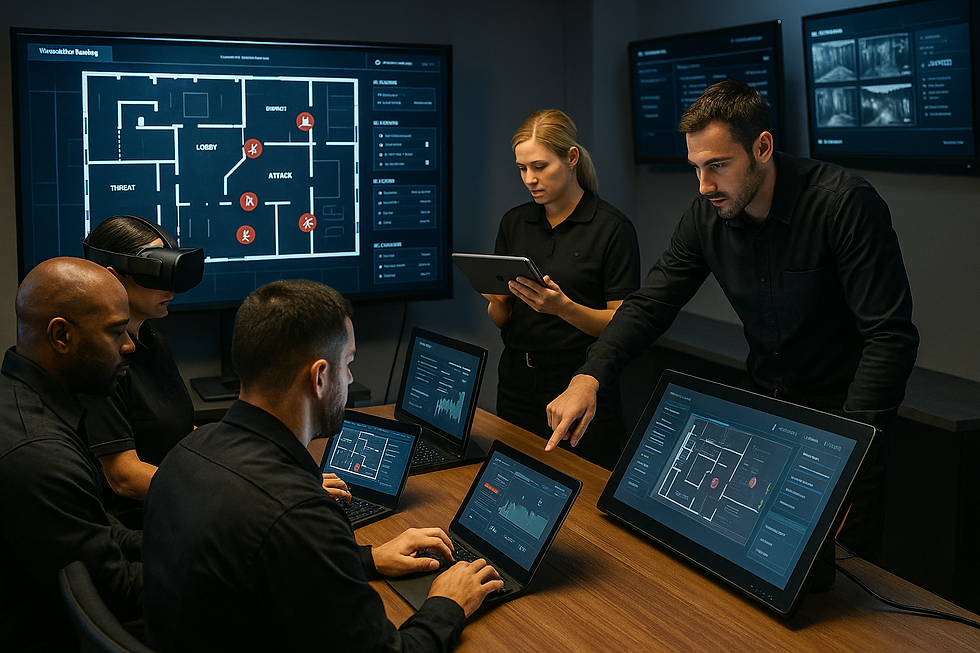Using Technology in Security Exercises and Instruction
- Sam Wilks

- Aug 22
- 3 min read

Security must never fall prey to tradition or nostalgia in the name of operational excellence. The constant discovery and filling of gaps, between risk and preparedness, between expectation and result, is what makes progress, not catchphrases or self-praise. The incorporation of technology into the training and drill regimens of contemporary security operations is the clearest example of this.
Character, discernment, and bravery cannot be replaced by technology. The unfit, the lazy, and the weak-principled cannot be made vigilant by any algorithm or gadget. However, technology is a potent force multiplier that can be used with intelligence and discipline to increase the scope, complexity, and realism of security planning. Effective deterrence is distinguished from meaningless ritual by the careful use of tools rather than their mere possession. The static, linear exercises of the past have been greatly outperformed by simulation platforms. Realistic, branching scenarios that mimic the uncertainty and pressure of actual incidents can be presented to today's security teams. These online settings enable intricate role-playing, impose time limits, and have the ability to dynamically escalate threats, requiring participants to adjust rather than simply repeat policy. Digital simulations, as opposed to live exercises, offer a challenging yet safe environment for frequent practice, quick iterations, and detailed performance evaluations, all without the safety hazards or administrative hassles of actual drills.
Technology for recording and replaying adds an element of objectivity that is all too frequently absent from conventional debriefs. Every move, response, and hesitancy can be seen and examined. Integration and replaying of data from communication channels, surveillance feeds, and access logs can reveal both strengths and weaknesses with unwavering clarity. This factual basis eliminates justification and embellishment. The performance is evaluated based on outcomes rather than stories.
Real-time feedback and assessments are now possible through wearable technology and smartphone apps. Even field exercises can be tracked for situational awareness, response times, and protocol adherence thanks to geo-fencing, biometric tracking, and incident logging. These tools bridge the gap between operational performance and training when used responsibly and with privacy in mind. Each drill's lessons are turned into useful information for the next one.
Crucially, technology makes it possible for security training to take place outside of the training room or classroom. Employees can participate remotely in policy updates, scenario walkthroughs, and refresher courses at a pace determined by operational pace rather than a formal calendar. In a setting where threats change more quickly than the inertia of conventional training cycles, this adaptability is crucial.
However, a word of caution is necessary. Despite all of its advantages, technology has the power to deceive the complacent into feeling secure. Just because a security officer passed a digital test doesn't mean they are prepared, and just because a drill was recorded doesn't mean it was successful. Technology's true worth is found in how rigorously it is used: Are shortcomings addressed or ignored? Are lessons stored and forgotten, or are they converted into altered behaviour? Performance under pressure, responsibility for outcomes, and adaptability are the same litmus tests.
The evidence is unmistakable, the companies that incorporate technology into their drills and training see measurably better results in actual incidents, quicker skill acquisition, and more accurate readiness assessments. However, the willingness to use these tools to test, evaluate, and enhance human capability is always more important than the tool's sophistication.
Technology is ultimately a servant, not a master. Its purpose in security drills and training is to highlight areas of weakness, enhance learning, and make sure that each exercise leaves the organisation stronger rather than just busier. The benchmark by which all training should be evaluated is still the unwavering pursuit of operational reality rather than technological innovation.
From the author.
The opinions and statements are those of Sam Wilks and do not necessarily represent whom Sam Consults or contracts to. Sam Wilks is a skilled and experienced Security and Risk Consultant with 3 decades of expertise in the fields of Real estate, Security, and the hospitality/gaming industry. Sam has trained over 1,000 entry level security personnel, taught defensive tactics, weapons training and handcuffs to policing personnel and the public. His knowledge and practical experience have made him a valuable asset to many organisations looking to enhance their security measures and provide a safe and secure environment for their clients and staff.



Comments